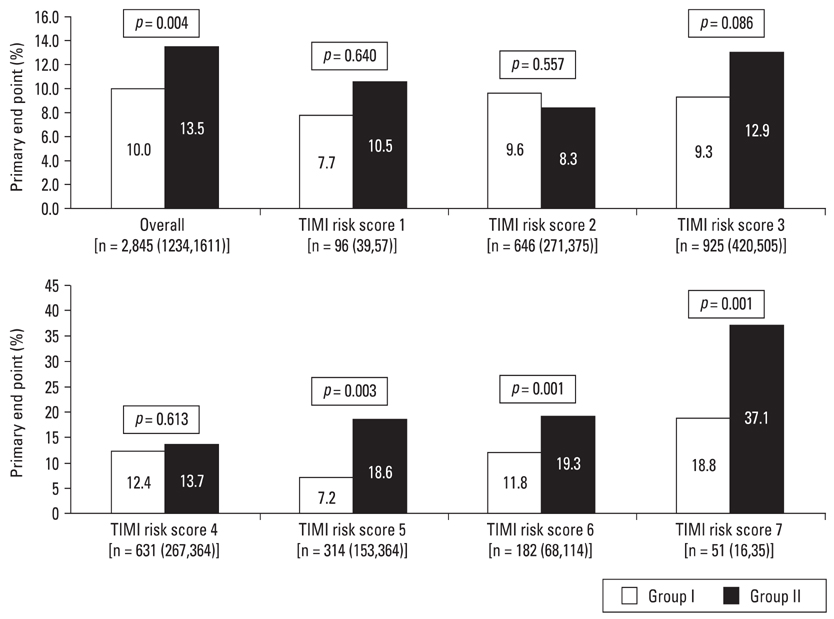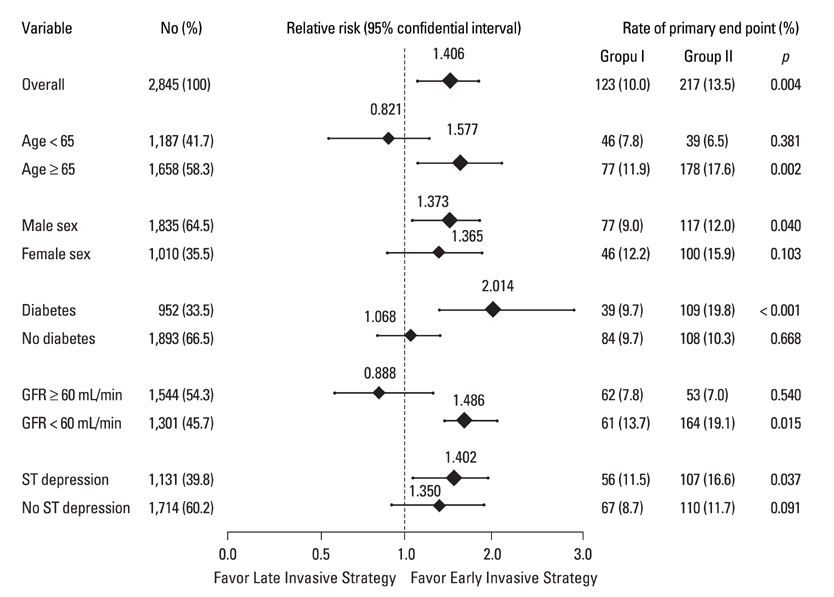Yonsei Med J.
2010 Jan;51(1):58-68. 10.3349/ymj.2010.51.1.58.
Long-Term Clinical Outcomes according to Initial Management and Thrombolysis In Myocardial Infarction Risk Score in Patients with Acute Non-ST-Segment Elevation Myocardial Infarction
- Affiliations
-
- 1Department of Internal Medicine, Chonnam National University Hospital, Gwangju, Korea. cecilyk@hanmail.net
- 2Department of Internal Medicine, Kyungpook National University, Daegu, Korea.
- 3Department of Internal Medicine, Keimyung University Dongsan Medical Center, Daegu, Korea.
- 4Department of Internal Medicine, Pusan National University Hospital, Busan, Korea.
- 5Department of Internal Medicine, Yeungnam University Hospital, Daegu, Korea.
- 6Department of Internal Medicine, Chungnam National University Hospital, Daejeon, Korea.
- 7Department of Internal Medicine, Chonbuk National University Hospital, Jeonju, Korea.
- 8Department of Internal Medicine, Jeonju Presbyterian Medical Center, Jeonju, Korea.
- 9Department of Internal Medicine, Seoul National University Bundang Hospital, Seongnam, Korea.
- 10Department of Internal Medicine, National University, Cheongju, Korea.
- 11Department of Internal Medicine, Konyang University, Daejeon, Korea.
- 12Department of Internal Medicine, Korea University Guro Hospital, Seoul, Korea.
- 13Department of Internal Medicine, Kyung Hee University Hospital, Seoul, Korea.
- 14Department of Internal Medicine, Yonsei University Wonju Hospital, Wonju, Korea.
- 15Department of Internal Medicine, Wonju University Hospital, Wonju, Korea.
- 16Department of Internal Medicine, Catholic University Hospital, Seoul, Korea.
- 17Department of Internal Medicine, Asan Medical Center, Seoul, Korea.
- 18Korea Acute Myocardial Infarction Registry (KAMIR) Study Group of Korean Circulation Society, Korea.
- KMID: 1779607
- DOI: http://doi.org/10.3349/ymj.2010.51.1.58
Abstract
- PURPOSE
There is still debate about the timing of revascularization in patients with acute non-ST-segment elevation myocardial infarction (NSTEMI). We analyzed the long-term clinical outcomes of the timing of revascularization in patients with acute NSTEMI obtained from the Korea Acute Myocardial Infarction Registry (KAMIR). MATERIALS AND METHODS: 2,845 patients with acute NSTEMI (65.6 +/- 12.5 years, 1,836 males) who were enrolled in KAMIR were included in the present study. The therapeutic strategy of NSTEMI was categorized into early invasive (within 48 hours, 65.8 +/- 12.6 years, 856 males) and late invasive treatment (65.3 +/- 12.1 years, 979 males). The initial- and long-term clinical outcomes were compared between two groups according to the level of Thrombolysis In Myocardial Infarction (TIMI) risk score. RESULTS: There were significant differences in-hospital mortality and the incidence of major adverse cardiac events during one-year clinical follow-up between two groups (2.1% vs. 4.8%, p < 0.001, 10.0% vs. 13.5%, p = 0.004, respectively). According to the TIMI risk score, there was no significant difference of long-term clinical outcomes in patients with low to moderate TIMI risk score, but significant difference in patients with high TIMI risk score (> or = 5 points). Conclusions: The old age, high Killip class, low ejection fraction, high TIMI risk score, and late invasive treatment strategy are the independent predictors for the long-term clinical outcomes in patients with NSTEMI.
Keyword
MeSH Terms
Figure
Cited by 1 articles
-
Gender-Based Differences in the Management and Prognosis of Acute Coronary Syndrome in Korea
Hee Tae Yu, Kwang Joon Kim, Woo-Dae Bang, Chang-Myung Oh, Ji-Yong Jang, Sung-Soo Cho, Jung-Sun Kim, Young-Guk Ko, Donghoon Choi, Myeong-Ki Hong, Yangsoo Jang
Yonsei Med J. 2011;52(4):562-568. doi: 10.3349/ymj.2011.52.4.562.
Reference
-
1. Bassand JP, Hamm CW, Ardissino D, Boersma E, Budaj A, Fernández-Avilés F, et al. Guidelines for the diagnosis and treatment of non-ST-segment elevation acute coronary syndromes. Eur Heart J. 2007. 28:1598–1660.2. Braunwald E, Antman EM, Beasley JW, Califf RM, Cheitlin MD, Hochman JS, et al. ACC/AHA guideline update for the management of patients with unstable angina and non-ST-segment elevation myocardial infarction 2002: summary article: a report of the American College of Cardiology/American Heart Association Task Force on Practice Guidelines (Committee on the Management of Patients with Unstable Angina). Circulation. 2002. 106:1893–1900.3. King SB 3rd, Smith SC Jr, Hirshfeld JW Jr, Jacobs AK, Morrison DA, Williams DO, et al. 2007 Focused Update of the ACC/AHA/ SCAI 2005 Guideline Update for Percutaneous Coronary Intervention: a report of the American College of Cardiology/American Heart Association Task Force on Practice Guidelines. Circulation. 2008. 117:261–295.4. Pollack CV Jr, Braunwald E. 2007 Update to the ACC/AHA guidelines for the management of patients with unstable angina and non-ST-segment elevation myocardial infarction: implications for emergency department practice. Ann Emerg Med. 2008. 51:591–606.5. de Winter RJ, Windhausen F, Cornel JH, Dunselman PH, Janus CL, Bendermacher PE, et al. Early invasive versus selectively invasive management for acute coronary syndromes. N Engl J Med. 2005. 353:1095–1104.
Article6. Hirsch A, Windhausen F, Tijssen JG, Verheugt FW, Cornel JH, de Winter RJ. Long-term outcome after an early invasive versus selective invasive treatment strategy in patients with non-ST-elevation acute coronary syndrome and elevated cardiac troponin T (the ICTUS trial): a follow-up study. Lancet. 2007. 369:827–835.
Article7. Mehta RH, Roe MT, Mulgund J, Ohman EM, Cannon CP, Gibler WB, et al. Acute clopidogrel use and outcomes in patients with non-ST-segment elevation acute coronary syndromes undergoing coronary artery bypass surgery. J Am Coll Cardiol. 2006. 48:281–286.
Article8. Cannon CP, Braunwald E, McCabe CH, Rader DJ, Rouleau JL, Belder R, et al. Intensive versus moderate lipid lowering with statins after acute coronary syndromes. N Engl J Med. 2004. 350:1495–1504.
Article9. Lee KH, Jeong MH, Ahn YK, Kim JH, Chae SC, Kim YJ, et al. Gender differences of success rate of percutaneous coronary intervention and short term cardiac events in Korea Acute Myocardial Infarction Registry. Int J Cardiol. 2008. 130:227–234.
Article10. Kwon TG, Bae JH, Jeong MH, Kim YJ, Hur SH, Seong IW, et al. N-terminal pro-B-type natriuretic peptide is associated with adverse short-term clinical outcomes in patients with acute ST-elevation myocardial infarction underwent primary percutaneous coronary intervention. Int J Cardiol. 2009. 133:173–178.
Article11. Sabatine MS, Antman EM. The thrombolysis in myocardial infarction risk score in unstable angina/non ST segment elevation myocardial infarction. J Am Coll Cardiol. 2003. 41:89S–95S.12. Tricoci P, Peterson ED, Roe MT. Patterns of guideline adherence and care delivery for patients with unstable angina and non-ST-segment elevation myocardial infarction (from the CRUSADE Quality Improvement Initiative). Am J Cardiol. 2006. 98:30Q–35Q.
Article13. Denardo SJ, Davis KE, Tcheng JE. Effectiveness and safety of reduced-dose enoxaparin in non-ST-segment elevation acute coronary syndrome followed by antiplatelet therapy alone for percutaneous coronary intervention. Am J Cardiol. 2007. 100:1376–1382.
Article14. Alexander KP, Newby LK, Armstrong PW, Armstrong PW, Gibler WB, Rich MW, et al. Acute coronary care in the elderly, part I: Non-ST-segment-elevation acute coronary syndromes: a scientific statement for healthcare professionals from the American Heart Association Council on Clinical Cardiology: in collaboration with the Society of Geriatric Cardiology. Circulation. 2007. 115:2549–2569.15. Jones PH. Clinical significance of recent lipid trials on reducing risk in patients with type 2 diabetes mellitus. Am J Cardiol. 2007. 99:133B–140B.
Article16. Yan AT, Yan RT, Tan M, Chow CM, Fitchett DH, Georgescu AA, et al. ST-segment depression in non-ST elevation acute coronary syndromes: quantitative analysis may not provide incremental prognostic value beyond comprehensive risk stratification. Am Heart J. 2006. 152:270–276.
Article17. Gibson CM, Dumaine RL, Gelfand EV, Murphy SA, Morrow DA, Wiviott SD, et al. Association of glomerular filtration rate on presentation with subsequent mortality in non-ST-segment elevation acute coronary syndrome; observations in 13,307 patients in five TIMI trials. Eur Heart J. 2004. 25:1998–2005.
Article18. Effects of tissue plasminogen activator and a comparison of early invasive and conservative strategies in unstable angina and non-Q-wave myocardial infarction: results of the TIMI IIIB trial. Thrombolysis in Myocardial Ischemia. Circulation. 1994. 89:1545–1556.19. Boden WE, O'Rourke RA, Crawford MH, Blaustein AS, Deedwania PC, Zoble RG, et al. Outcomes in patients with acute non-Q-wave myocardial infarction randomly assigned to an invasive as compared with a conservative anagement strategy. Veterans Affairs Non-Q-Wave Infarction Strategies in Hospital (VANQWISH) Trial Investigators. N Engl J Med. 1998. 338:1785–1792.
Article20. Wallentin L, Lagerqvist B, Husted S, Kontny F, Ståhle E, Swahn E. Outcome at 1 year after an invasive compared with a non-invasive strategy in unstable coronary-artery disease: the FRISC II invasive randomised trial. FRISC II Investigators. Fast Revascularisation during Instability in Coronary artery disease. Lancet. 2000. 356:9–16.
Article21. Cannon CP, Weintraub WS, Demopoulos LA, Vicari R, Frey MJ, Lakkis N, et al. Comparison of early invasive and conservative strategies in patients with unstable coronary syndromes treated with the glycoprotein IIb/IIIa inhibitor tirofiban. N Engl J Med. 2001. 344:1879–1887.
Article22. Fox KA, Poole-Wilson PA, Henderson RA, Clayton TC, Chamberlain DA, Shaw TR, et al. Interventional versus conservative treatment for patients with unstable angina or non-ST-elevation myocardial infarction. The British Heart Foundation RITA 3 randomised trial. Randomized Intervention Trial of unstable Angina. Lancet. 2002. 360:743–751.
Article23. Cavallini C, Savonitto S, Violini R, Arraiz G, Plebani M, Olivari Z, et al. Impact of the elevation of biochemical markers of myocardial damage on long-term mortality after percutaneous coronary intervention: results of the CK-MB and PCI study. Eur Heart J. 2005. 26:1494–1498.24. Roe MT, Mahaffey KW, Kilaru R, Alexander JH, Akkerhuis KM, Simoons ML, et al. Creatine kinase-MB elevation after percutaneous coronary intervention predicts adverse outcomes in patients with acute coronary syndromes. Eur Heart J. 2004. 25:313–321.
Article25. Westerhout CM, Fu Y, Lauer MS, James S, Armstrong PW, Al-Hattab E, et al. Short-and long-term risk stratification in acute coronary syndromes: the added value of quantitative ST-segment depression and multiple biomarkers. J Am Coll Cardiol. 2006. 48:939–947.26. Jaffe AS, Babuin L, Apple FS. Biomarkers in acute cardiac disease: the present and the future. J Am Coll Cardiol. 2006. 48:1–11.
- Full Text Links
- Actions
-
Cited
- CITED
-
- Close
- Share
- Similar articles
-
- Differences in Clinical Outcomes Between Patients With ST-Elevation Versus Non-ST-Elevation Acute Myocardial Infarction in Korea
- Development and Prognosis of Non-Q Myocardial Infarction
- Retroperitoneal Hemorrhage after Thrombolysis in ST Elevation Myocardial Infarction
- Acute Myocardial Infarction by Right Coronary Artery Occlusion Presenting as Precordial ST Elevation on Electrocardiography
- Effect of Angina Pectoris before Acute Myocardial Infarction on Degree of Residual Stenosis after Successful Coronary Thrombolysis



